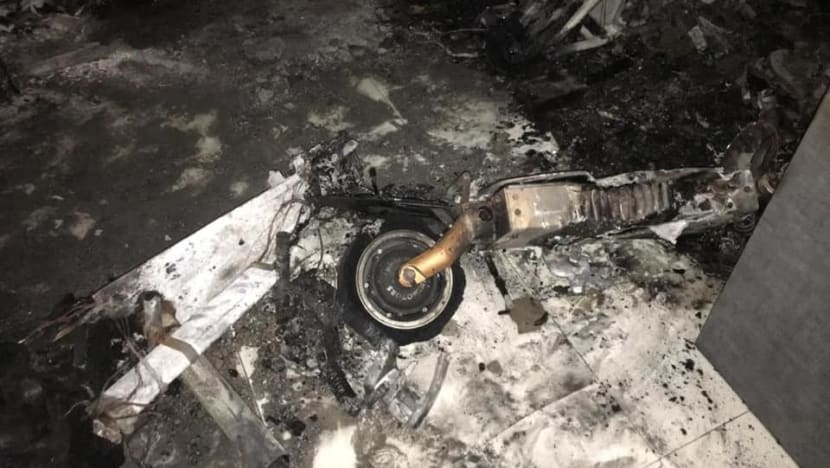Man died rescuing dogs after PMD left charging caught fire; coroner rules death unfortunate misadventure

There were three PMDs in the flat at Block 293D Bukit Batok Street 21 where a fire broke out. (Photo: Facebook/Murali Pillai)
SINGAPORE: A man who tried to rescue his dogs from a fire that broke out in his flat suffered burns on 40 per cent of his body and later died. A personal mobility device that had been left to charge had caught fire, which spread to the rest of the flat.
The coroner ruled 40-year-old Goh Keng Soon's death an unfortunate misadventure in findings made available this week.
Mr Goh and his wife lived in a flat in Bukit Batok Street 21. His wife told the court that Mr Goh had picked her up from work on Jul 17, 2019.
After telling her that the power to his Speedway-brand PMD had cut off, he began charging it in the living room next to his wife's two PMDs.
The couple watched television, then closed the living room windows and went to bed just before midnight.
At about 12.30am on Jul 18, 2019, Mr Goh's wife heard noises and woke her husband up thinking that there was someone in the living room.
However, when they opened the bedroom door, black smoke entered the room, she testified. She tried calling 995 twice, but the reception was bad.
She managed to confirm her address with the Singapore Civil Defence Force (SCDF) at 12.47am and they told her they were on their way.
The couple retreated into a walk-in closet connected to their master bedroom and opened the windows to get some air, but there was still a lot of smoke.
They used plush toys to cover their noses and headed towards the master bedroom toilet, but heard their two dogs barking from the living room.
Mr Goh told his wife to go to the toilet and wait, before leaving to rescue their dogs. Shortly after, she heard her husband scream and tried to open the toilet door, but the handle was too hot to the touch.
When the ceiling fixtures began to melt and fall on her, she climbed out of the toilet window and onto the air-conditioner ledge.
Meanwhile, the couple's neighbours gathered outside and tried to extinguish the fire using an internal hose reel from the lobby outside their flat.
SCDF ARRIVED TO FIND MR GOH PASSED OUT
Firefighters and police officers arrived at the flat on the 26th floor and forcibly entered the unit. They found Mr Goh collapsed on the floor in the common toilet, while his wife was on the aircon ledge outside. The two dogs were rescued.
Mr Goh and his wife were both taken to hospital. Mr Goh was assessed to be in cardiac arrest, with second-degree partial-thickness burns on about 40 per cent of his body. He died two days later on Jul 20, 2019.
His cause of death was certified as multi-organ failure following a heart attack with thermal burns and coronary artery disease.
A fire investigation report by the SCDF showed that the fire had originated in the living room where the PMDs were placed. As the circuit breaker had tripped, there was likely to be an electrical anomaly that was caused either by the charging of the PMD, or the effects of the fire from the living room.
Remnants of spent battery cells believed to be lithium-ion cells from the PMDs were recovered from the area where the fire originated.
The charging circuit was traced to the Speedway PMD, which had a two-pin plug inserted into a four-socket extension cord via a two-pin adapter. The extension cord was connected to the wall socket.
OVERHEATING, LOOSENED CONTACTS FOUND
Localised resistance overheating with arching and melting was found at the two-pin plug and the charging port in the PMD, due to loosened contacts and a faulty charger.
Overheating was also found in the battery packs of the Speedway PMD, due to an ineffective battery management system. The damage to the other two PMDs was secondary in nature, caused by the radiant heat flux from the fire outbreak which resulted in a thermal runaway in the two other PMDs, causing further heat damage in the living room.
A technical report concluded that the fire was primarily caused by the overheating at the two-pin plug and charging port while the Speedway PMD was being charged.
An expert noted that the two-pin plug used in this case had flat pins and not cylindrical pins. He said the connection would not be good if a flat two-pin plug is connected to a socket that is not adapted for such a plug, as there may be a loose connection that could lead to overheating.
He gave the following recommendations: Charge PMDs or their batteries in a fully ventilated flat space and away from combustible materials; Do not leave charging devices unattended for an extended period of time or overnight; Maintain the PMDs in accordance with the manufacturer's recommendation and promptly replace any faulty adapters or chargers; Regularly examine batteries for damage or deformities such as burns, punctures, bulging, cracks, corrosion or powdery residue; and buy and use only PMDs with the UL2272 certification mark; Do not modify PMDs.
Police investigations found that the couple had bought the Speedway PMD in 2016 and did not modify the battery pack. They had used the same battery pack since it was first purchased and did not buy an additional charger for it.
PMD BOUGHT BEFORE STRICTER SAFETY REGULATIONS IMPOSED
According to the coroner's report, the PMD was designed in Korea and manufactured in China, and there were no compliance requirements or regulations set by the Land Transport Authority when it was marketed in Singapore.
A manager of LTA's active mobility group said that only UL2272 certified devices were allowed on cycling paths from Jul 1, 2020, a year after sale of non-UL2772 devices was banned.
Between 2017 and 2018, SCDF attended to 101 fires caused by non-UL2272 certified PMDs like the Speedway.
The UL2272 standard was announced in September 2018 and is a fire safety standard for motorised PMDs. However, even if a PMD has the certification, it does not mean it will not overheat or catch fire, and users should still adopt proper and safe handling of PMDs - such as not modifying their devices, not overcharging batteries and not leaving their devices unattended when charging.
The LTA manager added that users should avoid exposing their PMDs to water. If the device is exposed to wet weather conditions, it should be wiped dry immediately after use.
The coroner said there is no basis to suspect foul play, but said this "tragic incident demonstrates the grave dangers of using the non-UL2272 certified PMDs".
She advised owners of such devices to dispose of them, as they pose a significant fire risk, and conveyed her condolences to Mr Goh's family for their very sad loss.












